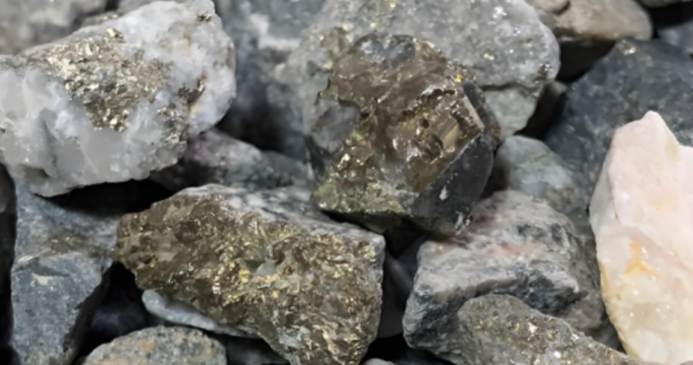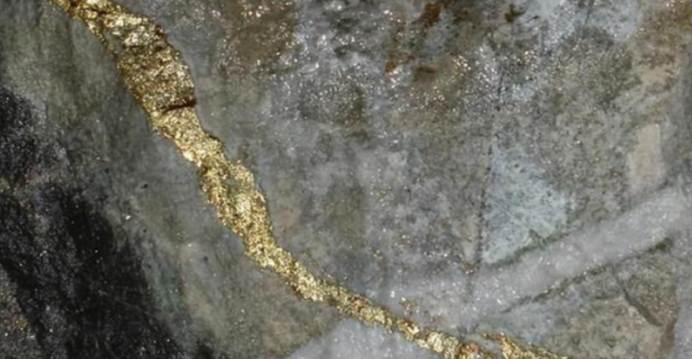Gold in nature exists mostly in the form of monomers, and metal compounds such as selenium, tellurium, and antimony are occasionally seen, but non-metallic compounds are extremely rare. Gold ores are mainly divided into two categories: alluvial gold ores and rock gold ores, while rock gold ores can be subdivided into quartz vein type, fracture zone alteration rock type, fine vein dipping type, and quartz-calcite type. To address the characteristics and pain points of different types of gold ores, HT color sorter's ore sorting and AI sorting technology provide customized solutions to promote the upgrading of the beneficiation process to high efficiency and green.

First, alluvial gold mine: water conservation and efficiency, cracking the problem of resource recovery Alluvial gold ore is formed by primary gold ore through long-term water erosion, wind erosion and deposition, and according to the cause can be divided into gravity sand, flowing water sand, glacial sand and coastal (lake) sand. The beneficiation of alluvial gold is mainly re-election and enrichment. Most of the alluvial gold sands in China are flaky, or because of the long history of sand mining, the rest are flaky fine particles. Easily selectable alluvial gold ores should have more sand and less mud, with coarse sand and fine gold, otherwise they are considered difficult to select. In China, water guns and sand mining boats are commonly used for sand mining. Boundary grades are usually not required due to low cost and large scale. Generally industrial grade up to 0.1g/t (0.15g/m³) can be mined, while 0.3g/t alluvial gold ore is already rich. Alluvial gold mining cannot be done without water, and whether water can be recovered or not is the main factor affecting the cost of alluvial gold mining.
Second, rock gold mine: classification policy, overcome the bottleneck of mineral processing technology From the geological reasons, rock gold can be roughly divided into three categories: igneous rock, sedimentary rock and metamorphic rock. Among them, China is dominated by igneous and metamorphic rocks, and there are fewer gold deposits in sedimentary rocks. According to the data from previous exploration, the grade of gold in igneous rocks decreases with the acidity of the rocks. The highest grade is pure peridotite and olivine, followed by amphibolite, and basalt. The lowest grade is in granite. However, it is well known that the higher the basic properties of a rock, the more susceptible it is to oxidation and weathering. Therefore, it is often said that “easy to grind and difficult to select, easy to select and difficult to grind” is a certain truth. Generally speaking, rock gold ore can be divided into quartz vein type, broken zone alteration rock type, fine vein dipping type, quartz calcite type from the point of view of mineral processing.

1. Quartz vein type gold ore: digging gold from waste rock, realize double benefits quartz vein type gold ore with pyrite as the main gold-carrying minerals, gold endowed with vein fissures. Traditional flotation needs to process a large amount of quartz vein, resulting in high cost and waste of resources. Ore color sorter using pure quartz and pyrite associated quartz ore surface characteristics of the industry, the use of photoelectric color sorter technology to sort out the pure quartz and gold-bearing pyrite, selected pure quartz ore can be directly sold as raw materials; and gold-bearing pyrite concentrate grade can be greatly improved, to a place in Henan, for example, the vein quartz gold ore, into the flotation of the amount of ore is reduced by 40%, the grade of the gold ore is increased by morhttps://www.htcolorsorter.com/e than 50%.
2. Crushing zone alteration rock type gold mine: pre-enrichment to reduce the risk of tailings Crushing zone alteration gold deposit veins are mainly quartz and silk mica, metal minerals are mainly pyrite, in the form of fine vein dipping, gold and sulfide ores are coexisting, and the peripheral rock alteration is dominated by silica, kaolinite, silk mica and carbonate. In addition to pyrite, the sulfide ore is readily associated with chalcopyrite, galena, sphalerite, etc. Deposits of this type are usually easy to select and high recoveries can be obtained by individual flotation. If the weathering is serious, the tailings can be recovered twice by whole mud cyanidation. As for the low-grade ores in this type of mines, the gold-bearing sulfide ores in the associated ores are identified through the use of AI ore sorting, and the low-grade enclosing rocks are thrown away, so as to achieve the upgrading of the gold grade to realize the recycling of the gold ore resources.
3. Quartz-calcite-type gold ore: efficient activation of dispersed resources The vein minerals of quartz-calcite gold deposits are quartz and calcite, and the gold minerals are bubbling in the vein minerals and metal minerals, and the metal minerals range from simple to complex, and the majority of them contain poisonous sands, staghornite, magnetic pyrite, black copper ore and so on. Due to the good distribution of gold and the large influence of metal minerals on the mineral selection process, it is difficult to take into account both the efficiency and economy of the sorting process through a single process. efficiency and economy. Pre-selection is carried out by capturing the differences in multi-dimensional characteristics of quartz, calcite and associated minerals on the surface (such as spots, color, texture, etc.), and the pre-selected concentrate is used for recovering gold through flotation, which can greatly reduce the amount of flotation scale.
Technology empowerment: from cost reduction and efficiency increase to green mine The core of HT color sorter sorting technology lies in multi-dimensional perception and resource recycling: accurate sorting: spectral recognition accuracy > 99%, can handle low-grade ore with a boundary grade of 0.3g/t; zero-waste target: quartz, calcite and other veins are turned into treasures, and the amount of tailings is reduced by 50%-70%. HT color sorter technology not only solves the problem of “high cost and low recovery rate” in traditional ore dressing, but also reconstructs the economic model of mines with resourceful thinking by precisely adapting to different types of rock gold deposits. From “turning waste rock into building materials” for quartz vein mines to “AI pre-enrichment” for complex associated mines, technological innovation is driving the industry to move forward in the direction of high efficiency, greenness and sustainability.
